
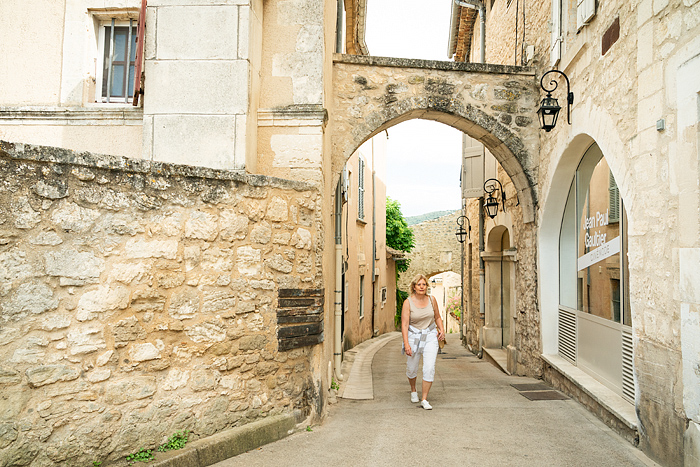 Looking for a day trip that combines ancient architecture, a dark history and artsy fashion design?
Looking for a day trip that combines ancient architecture, a dark history and artsy fashion design?
Then make your way to tiny Lacoste village in the Luberon Valley…

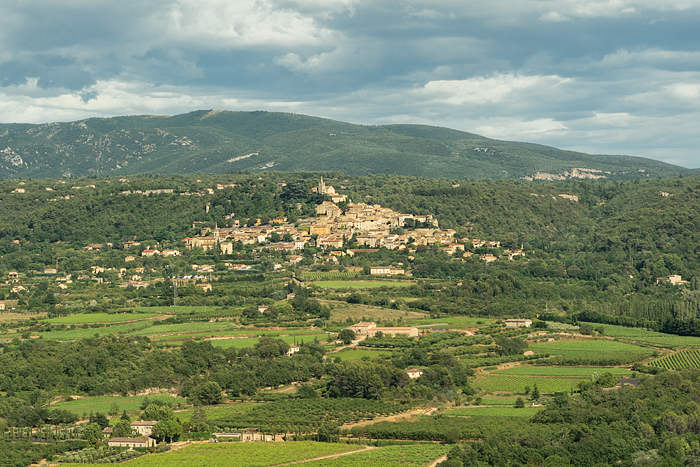
That’s what my daughter, Jordan, and I did. Continuing our road trip in Provence, we travelled to this evocative place tinged with darkness and an artistic bent. Seen from afar, Lacoste village sits high on a forested hill in the Petite Luberon Mountains. The striking cluster of homes cascading down the slope crowned by a crumbling castle catches your eye from across the valley.
First mentioned in written documents waaay back in 1038, this village has stone homes still standing from 9th century. Lacoste village is unique in that it offers tourists a chance to see both ruins and fashion and art alike. Not only did famous designer Pierre Cardin buy the Lacoste village castle, but the American Savannah College of Art & Design also established a campus here. Visit and you might see exhibits featuring famous artists, student galleries or fashion shows. Or have the chance to attend live opera, dance or theatrical productions in the castle’s rock quarry.
Traveling to Lacoste village
Situated 25 miles east of Avignon, where you can travel by fast train from Paris, Lacoste village is easily reached by rental car on paved roads.
Leaving our B&B in Beaumettes (near Gordes), we drove east on D900/D106 past vineyards and lavender fields, and arrived Lacoste village 11 minutes later. Like other Provencal villages, public parking is on the outskirts of town. We parked beside St. Trophime church, an austere, plain looking building, and peeked inside.
Historically, there were monks who had a priory here before the village even existed. The Romanesque interior had high arches, lit candles and frescoes in the vaulted space. It’s the burial place of the Simiane family who first lorded over Lacoste village long, long ago between the 11th-16th centuries.

.jpg) A few steps from the parking area was Le Cafe de France, an outdoor cafe with a hanging terrace. And a mini-mart! Neither existed when I last visited–20 years ago. Likely necessary additions for the university students as SCAD’s study abroad summer program has now expanded to semesters year round. Other than a cafeteria for students, there’s no restaurants within the medieval walls.
A few steps from the parking area was Le Cafe de France, an outdoor cafe with a hanging terrace. And a mini-mart! Neither existed when I last visited–20 years ago. Likely necessary additions for the university students as SCAD’s study abroad summer program has now expanded to semesters year round. Other than a cafeteria for students, there’s no restaurants within the medieval walls.
Soon we reached the original entrance of Lacoste village, Portail de la Garde. An intriguing portal to ancient times. This grand gate is where guards once stood, vigilantly protecting the inhabitants from their enemies.
A little history about Lacoste village~
Living in Provence hadn’t been easy. There were plagues, wars and banditry. During the Middle Ages, Lacoste village was part of an enclave that belonged to the Pope, as part of his Comtat Venaissin territory. But in 1481, Lacoste became part of France, and the Romans moved out.
The new inhabitants of Lacoste village embraced Protestanism, which angered the Pope, who still ruled neighboring villages Menerbes and Bonnieux. Religious Wars were in full force. Lacoste became a sanctuary for those fleeing religious persecution, even families from the Swiss Alps.
In 1545, Maynier d’Oppede, who was the President of Parliment in Aix-en-Provence, took it upon himself to cleanse all non-Catholic heretics from the Luberon. Which now included Lacoste village. He stood at this very gate, promising to spare the inhabitants if the guards would let them in to rest and dine (exhausted after plundering other villages). Oh, such naivety. Once granted permission to enter, d’Oppede and his troops swept in and let loose on a frenzied killing spree, pillaging, raping, slaughtering men, women and children. All inhabitants were murdered except for a few lads who were kidnapped and taken away by the troops.
It was eerie to think about as we passed through this very same gate.

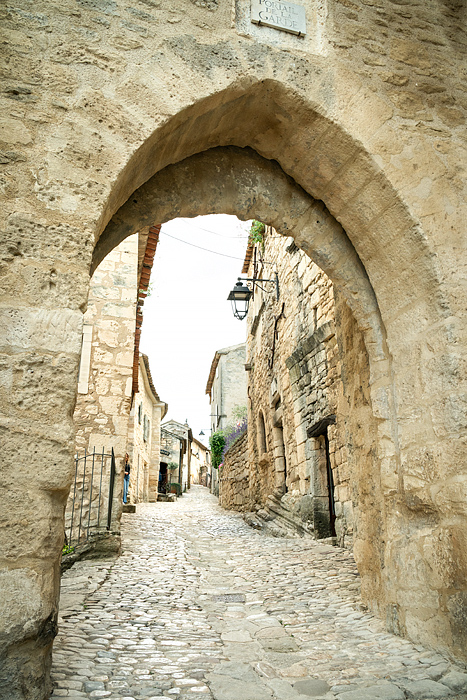
Are we time-traveling? It certainly looks like a portal to a different era!
The vacant village sat dormant for many years. And fell into ruin. Eventually a few straggled back in. The Simiane family still owned the castle, although it is not known if they ever moved back into the chateau. In 1716, Isabelle Simiane sold the château and surrounding land to Gaspard François de Sade. Population of the village grew to nearly 400 by the time his grandson, Marquis de Sade occupied the chateau. (More about him later.) Restoration of the village was an ongoing battle due to destructions caused by the French Revolution, lasting 1789 to 1794, and World War II.
By 1950, it was completely deserted.
Even now, decades later, renovated and inhabited with locals and students alike, it seemed quieter than I expected. A few students were scattered about walking arm in arm, or sitting in alcoves discussing, laughing, or conversing. In English!
Walking over enormous cobblestones along Rue Sainte Trophime, we wandered past weathered facades up toward the chateau. Ancient stone homes extended three-stories high behind fortressed walls. The narrow lane looked like a movie set. But was just frozen in time.

.jpg)
Those cobblestones!!
Renovation of Lacoste village
How sad these buildings must’ve looked from the devasting effects of wind, rain, war and time. Minus any upkeep. That’s the condition American painter Bernard Pfriem would’ve seen when he wandered through this vacant village in 1952. But he envisioned beauty in the ruins. And thanks to him, Lacoste village is no longer a ghost town.
In 1961, Bernard and his then partner Maxime de la Falaise, a model, actress and fashion designer, moved from Paris to Lacoste. Their initial vision was to create an artist colony for her entourage of Parisian socialites and artists. But that dream dissolved when she left. By 1967, Maxime was living in NYC, and married to John McKendry, curator of the Metropolitan Museum of Art.
But Bernard stayed put, renovating Lacoste village ruins to create an Art College after his alma mater, the Cleveland Institute of Art. Most of the dilapidated homes were roofless. He snatched up 20 homes in the upper part of the village for $500.

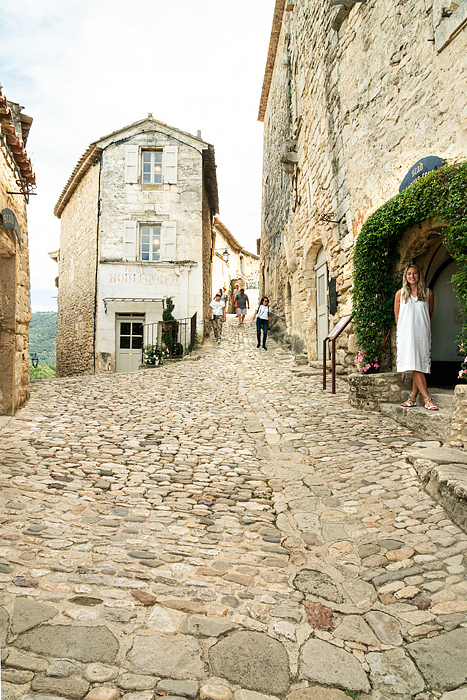
College student welcomes visitors to SCAD
One of the buildings he bought was the old Boulangerie. Instead of paying cash, he bartered one American refrigerator. (Apparently his portrait hangs across a short arched doorway inside the former bakery, requiring students and visitors alike to bow down when passing through, thereby paying homage to Bernard Pfriem, founder of the art school. And an exhibition at the Galerie Pfriem on rue Trophime features some of his original works, a biographical video and artistic achievements in Lacoste.)

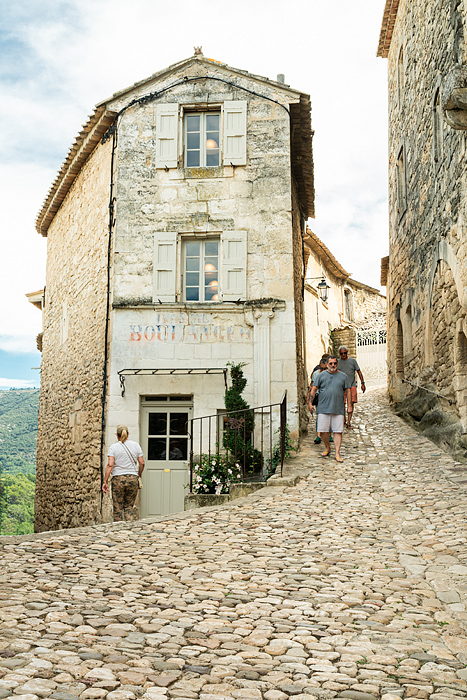
This former Boulangerie is now SCAD’s library
Fashion designer Pierre Cardin also renovated old stone homes, after he bought the chateau in Lacoste village in 2001. He converted cavernous homes into studio spaces and galleries, and two mansions into hotels. His intent was to draw people to Lacoste, making it the “Saint-Tropez of Culture.” This caused much division in the tiny community as he was buying up properties at an alarming rate. Some were purchased just to house performers, staff and guests in July when he hosted his annual music, theatre, dance festival at the chateau. Residents were angered that property rates climbed so high that locals couldn’t afford to buy. Cardin soon owned 50 homes, a third of the village.
The other major renovator of Lacoste village was SCAD, the Savannah College of Art and Design, who came a year later. In addition to fixing water leaks and missing roofs in 30 village homes, they also renovated Marqui de Sade’s large farmhouse and horse stables in the valley below. And added a pool, quirky decor and beautiful Provencal furnishings for the college students. And a screen to host outdoor film shows. Walk through the village and you’ll see little alcoves like this that exhibit student art.

.jpg)
Lacoste village Art schools
Bernard opened his Lacoste Art School in 1970. A charismatic educator and influencer, he attracted famous visiting artists like Max Ernst, Man Ray, Lee Miller, and photographer Henri Cartier-Bresson to his school in Lacoste. When he died in 1996, the decaying art school began looking for a buyer.
Another American, Paula Wallace, President of SCAD, the Savannah College of Art and Design in Georgia, came to have a look. And was obviously smitten with the Provencal village. After purchasing and renovating the Lacoste Art School and its 30 buildings, SCAD began sending students over for summer abroad studies in 2002. Today this European campus offers classes year round, drawing 500 students annually from the Savannah and Atlanta campuses to study photography, graphic arts, cinema, advertising, architecture, and fashion design. Students not only draw inspiration from this medieval village set in an idyllic landscape, but also from famous artists. Including, up until his death, Pierre Cardin who was a champion of SCAD and mentored its students.
Imagine living in Lacoste village for a semester. What an inspiring place to study! (Wanna go? Details here about their program.)
Art & fashion exhibits
One of the highlights of visiting Lacoste village is seeing the revolving art and fashion exhibits of both famous artists and SCAD college graduates.
SCAD FASHION Museum often features internationally knowned artists. This year, until September 30, 2024, SCAD Museum features renowned French fashion designer, Jean-Paul Gaultier.
He began his career with Pierre Cardin at age 18, in 1970. And just six years later founded his own fashion house. Considered one of the world’s greatest couturiers, Gaultier is celebrated for his rebellious and provocative collections.

.jpg)
The exhibit, a condensed version of Jean-Paul Gaultier’s Cinemode that showed in Paris and Spain, showcases fantastical costumes that he created for films. Gaultier was in Lacoste on opening day of the exhibit, May 1st, 2024. He held a masterclass for the students at SCAD dicussing his vision between fashion and cinema.

.jpg)
Like his costumes for Mad Max, The Third Element, and Clockwork Orange.

.jpg)
So many of his costumes were instantly recognizable. He was the designer for Madonna’s Blond Ambition tour too.

.jpg)
Student Gallery
We also saw the La vue d/ici exhibit which showcases fashion designs from SCAD alumni graduates. Mannequins display pieces that the students designed. Most of the pieces walked on major runways. And you can watch a video playing snippets of those live fashion shows.

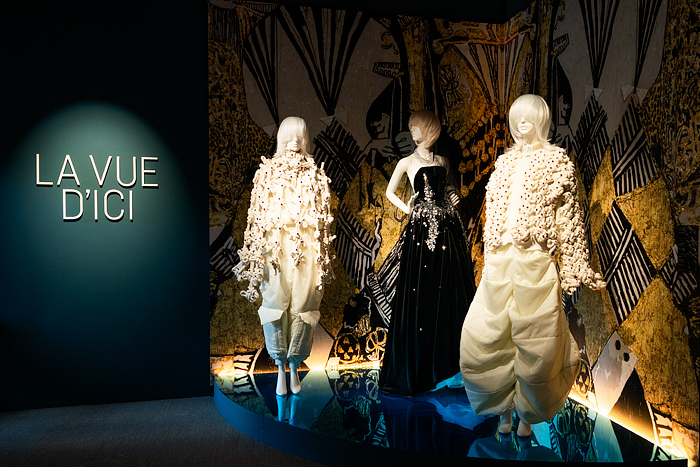
Students not only designed these elaborate outfits but printed their own fabric too.

.jpg)
One design was even worn by Björk on her tour. For Project Runway fans, like me, this exhibit was fun to see. This current exhibit ended Sept 30, 2024.
Shops ~
Each summer SCAD invites 5 promising up-and-coming graduates to hone their crafts. They are provided with an atelier along the Rue des Artistes to hone their craft. Open to the public, you can pop in and see what they’re working on. You might see some of the artists standing at the entrance to their shop engaging with tourists and encouraging them to come inside.
Also on this street you’ll find ShopSCAD, a great place to buy paintings, jewelry, ceramics and leather work.
Pierre Cardin also created a shop, Divine Marquis. After all, his affluent guests would need foi gras, pate, exotic teas, and hampers of Maxim’s champagne. But honestly don’t know if it is still here. We didn’t see it anywhere.

.jpg) We continued our jaunt up toward the castle, following the cobblestone lane around sharp bends. And soon passed the Belfry, built in 1550, which marks the entrance to the castle core.
We continued our jaunt up toward the castle, following the cobblestone lane around sharp bends. And soon passed the Belfry, built in 1550, which marks the entrance to the castle core.

.jpg)
Lacoste village Chateau
Not much is known about the Simiane family of the House of Agoult who built the Lacoste village chateau in 11th century. Except that they lorded over these lands for generations.
In 1716, Isabelle Simiane sold the château and surrounding land to Gaspard François de Sade. He was the grandfather of the infamous hedonist, Marquis de Sade, who often visited as a child.

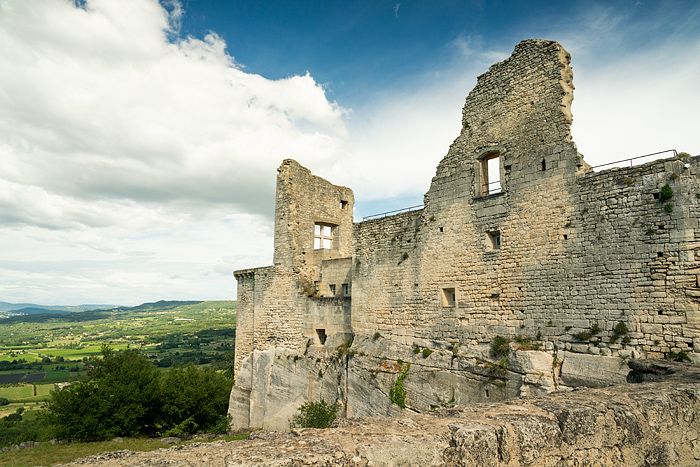
Marquis de Sade
Marquis received the 42-room chateau as his wedding present in 1763. It was his most beloved property, and he lived here for long stretches in his 20’s and 30’s between scandals, arrests and imprisonments. Exiled from Paris for his radical political writings, he was a naughty aristrocrat who hosted wild parties and lavish theatrical performances in his chateau. He also committed atrocious physical, blasphemous and sexual acts with young house servants and prostitutes that landed him in prison, on-and-off, for 27 years. During imprisonment, he wrote freely about his political and deviant views, coining the term, sadism.
Less known about him, was his love for theatre and desire to be remembered as a great playwright. During his longest stay, from 1769-1772, he built a large 120 seat theatre. He produced plays with lavish sets and elaborate costumes and often performed as one of the actors. He apparently was obsessed with fashion–fitting in with subsequent inhabitants! In a later 1781 prison letter to his wife, he asked her to send a “prune-colored riding coat with a svede vest, lightweight trousers but not linen” and a “Paris mud-hued suit with silver trimmings but no silver braids.”
Hiding here to escape arrest, he renovated the exterior to create an impenetrable fortress. He loved his chateau refuge. But in 1792, walls crumbled under damaging blows during the French Revolution. And in October 1796, he was forced to sell it due to insurmountable debt.
In 1801, at the age of 61, he was imprisoned again. Then three years later committed to an insane asylum where he continued to write, perform in plays and live with his 15 year-old lover (who pretended to be his illegitimate daughter). He died at age 74 in 1814.
After the subsequent owner, Rovere (a member of Parliment who was deported to French Guyana) died, the chateau sat empty. And fell deeper in decay. Lying in ruin for centuries, it served as a stone quarry for building materials. No longer an imposing castle.

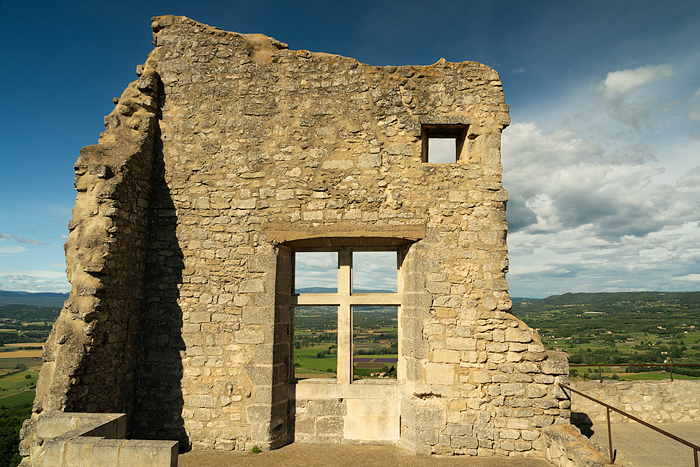
This jagged silhouette high on the hill is a haunting reminder of a time long ago.
André Bouer
In 1952, an English literature professor, André Bouer, bought the castle. And began a long 30 year process of restoring the collapsed vaults and walls.
Pierre Cardin
In 2001, avante-gard fashion designer Pierre Cardin purchased the Lacoste village chateau and its 70 acres. He completed structual renovations throughout the property, but restored rampart terraces and a few interior rooms selectively, wanting to keep it looking as if it hadn’t been touched by a modern hand. Inside, he filled a few rooms with his personal art and furniture collection from around the world.
Spending summers in this country retreat, he enjoyed hosting month-long concerts, theatrical performances, dances and operas in the courtyard and quarry behind the château. The program varies every summer, mixing internationally known artists with fresh young talents on the cusp of promising careers. And has continued every July for the last 20 years, even after his death in 2020.
Touring the castle
Visitors can tour the castle every afternoon from 2-6pm, for 8 euros. Some people balk over the admission price as there’s not a whole lot to see inside. But we were keen to look around.

.jpg) Walking through the silhouetted profile of Marquis de Sade, we crossed the drawbridge over a grassy moat. Reaching a courtyard, we followed stairs up to the terraced ramparts.
Walking through the silhouetted profile of Marquis de Sade, we crossed the drawbridge over a grassy moat. Reaching a courtyard, we followed stairs up to the terraced ramparts.
The rooftop offered an expansive view over groomed lavender fields and cherry orchards in the valley below. Had we been here in May, the fields would’ve been dotted red with poppies.

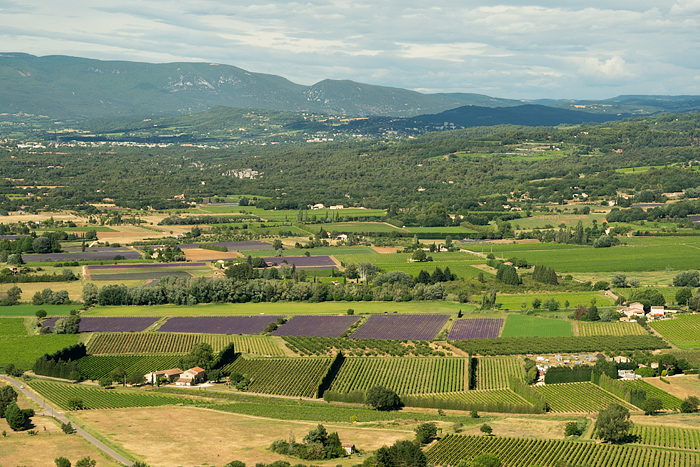
Back at ground level in the courtyard, we entered a door leading into the chateau.

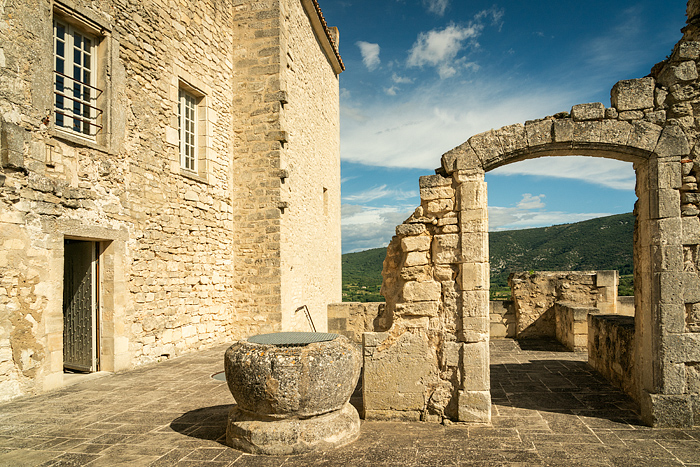
Wandering through the rooms we saw a bedroom, a library, salon and dining room. Only a few rooms are open to the public. The guard’s room barracks and infamous dungeon is completely off-limits. Some of the rooms were pretty bare with nothing much more than a single desk or chair. A strangely innocent-looking portrait of Marquis wearing a powdered wig hung on one of the walls, striking a jarring discord– knowing what we know about his life!
Pierre Cardin’s collection of art and furniture still occupy the rooms as he left it.

.jpg)
Cardin’s dining room set
Uphostered 17th and 18th century chairs share space with pre-Columbian masks, Renaissance cabinets, Oriental divans and a Buddha that he bought ages ago. Some are clearly priceless antiques. We also saw personal letters (couldn’t read them–in French) and police reports about Marquis de Sade’s arrests.

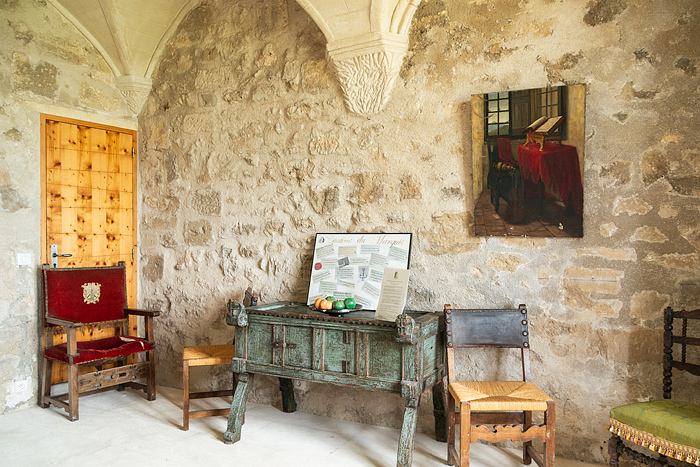
There were also framed comicbook and pencil drawings on the walls which looked oddly out of place.

.jpg)
Pierre collector chair with winner’s art exhibited
Until I later learned that as a member of the Academy of Fine Arts, Cardin had awarded annual prizes to a painter, sculptor, architect, engraver and composer since 1993. He exhibited their works on his castle walls every summer for festival-goers to see. Even after his death, both the awards and exhibits continue. This year, the exhibit lasts until October 10, 2024.

.jpg)
The exterior is accessible at all hours. There’s no gate, fence or fee to walk around the outside of the chateau.
Art adorns the grounds. Bronze sculptures include extra long arms spreading wide, and crossed arms below a caged bust of Marquis de Sade. Hmmm… Interpret as you may!

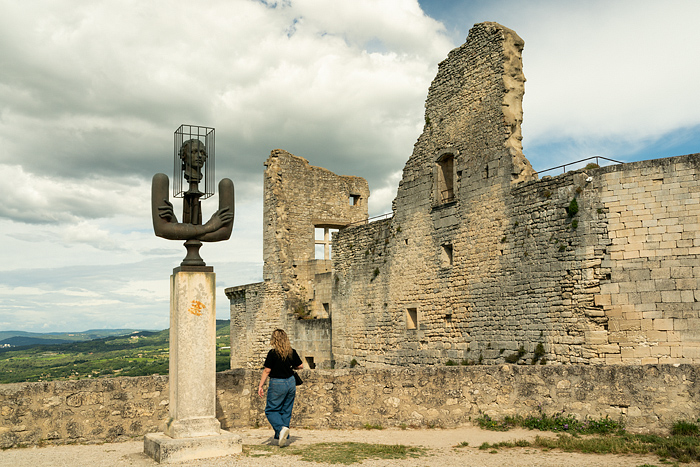
We didn’t stay till dark. But I imagine it would be quite a sight to see this fragmented castle on an eerie, stormy night. And perhaps hear soulful spirits whispering in the wind?
~~~~~~~~~~~~~~~~~~~~~~~~~~~~~~~~~~~~~~~~~~~~~~~~~~~~~~~~~~~~~~~~~~~~~
If you wanna add pics to your Pinterest board…

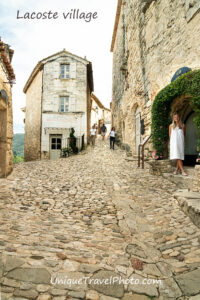

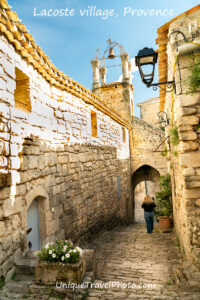



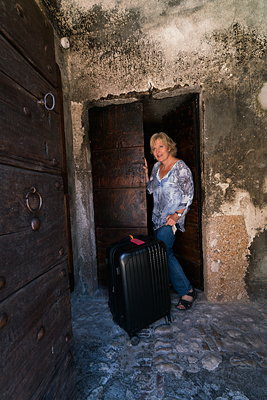
.jpg)